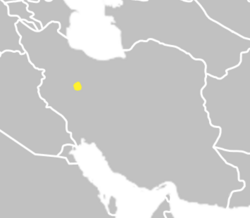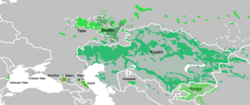Turkic languages
The Turkic languages are a language family of some thirty languages. They are spoken by Turkic peoples across an area from Eastern Europe and the Mediterranean to Siberia and Western and Northern China. Traditionally, people think that they are part of the Altaic languages.[1]
| Turkic | |
|---|---|
| Geographic distribution: | Eastern Europe Caucasus West Asia Central Asia North Asia (Siberia) East Asia (Far East) |
| Linguistic classification: | One of the world's primary language families |
| Proto-language: | Proto-Turkic |
| Subdivisions: | |
| ISO 639-5: | trk |
 Distribution of Turkic languages | |
Turkic languages are spoken by some 150 million people as a native language;[2] and the total number of Turkic speakers is about 180 million, including speakers as a second language. The Turkic language with the greatest number of speakers is the Turkish, or Anatolian Turkish. Its speakers are about 40% of all Turkic-speakers.[1]
History
The geographical distribution of Turkic-speaking peoples across Eurasia spreads from Turkey to Siberia.[3]
Classification
The number of speakers derived from statistics or estimates (2019) and were rounded:[4][5]
| Number | Branch | Languages | Status | Native Speakers | Main Writing System |
|---|---|---|---|---|---|
| 1 | Oghuz languages | 8 | Normal | 108,000,000 | Latin |
| 2 | Karluk languages | 4 | Normal | 69,000,000 | Latin |
| 3 | Kipchak languages | 12 | Normal | 31,300,000 | Latin |
| 4 | Siberian Turkic languages | 9 | Vulnerable | 800,000 | Cyrillic |
| 5 | Oghur languages | 1 | Vulnerable | 1,200,000 | Cyrillic |
| 6 | Arghu Turkic language | 1 | Vulnerable | 20,000 | Perso-Arabic |
| Total | Turkic languages | 35 | Normal | 210,000,000 | Latin |
Languages by native speakers
- Further information: Lists of endangered languages, List of endangered languages in Russia, and List of endangered languages in China
The Turkic languages are a language family of at least 35 [6] documented languages, spoken by the Turkic peoples. The number of speakers derived from statistics or estimates (2019) and were rounded:[4][5]
Further reading
- Johanson, Lars. 1998. "The history of Turkic." In: Johanson & Csató, pp. 81–125.
- Johanson, Lars. 1998. "Turkic languages." In: Encyclopaedia Britannica. CD 98. Encyclopædia Britannica Online, 5 sept. 2007.
- Menges, K. H. 1968. The Turkic languages and peoples: An introduction to Turkic studies. Wiesbaden: Harrassowitz.
Turkic Languages Media
Proto-Turkic homeland and expansion.[7]
Old Turkic Kul-chur inscription with the Old Turkic alphabet (c. 8th century). Töv Province, Mongolia
The 9th-century Irk Bitig ("Book of Divination") from Dunhuang, written in Old Uyghur language with the Orkhon script, is an important literary source for early Turko-Mongol mythology.
Yuan dynasty Buddhist inscription written in Old Uyghur language with Old Uyghur alphabet on the east wall of the Cloud Platform at Juyong Pass
Other websites
References
- ↑ 1.0 1.1 Katzner, Kenneth (March 2002). Languages of the World, Third Edition. Routledge, an imprint of Taylor & Francis Books Ltd. ISBN 978-0415250047.
- ↑ Turkic Language family tree entries provide the information on the Turkic-speaking populations and regions.
- ↑ Turkic Language tree entries provide the information on the Turkic-speaking regions.
- ↑ 4.0 4.1 https://www.ethnologue.com/
- ↑ 5.0 5.1 https://glottolog.org/
- ↑ Dybo A.V., Chronology of Türkic languages and linguistic contacts of early Türks, Moscow, 2007, p. 766, "Archived copy" (PDF). Archived from the original (PDF) on 2005-03-11. Retrieved 2005-03-11.
{{cite web}}: CS1 maint: archived copy as title (link) (In Russian) - ↑ Uchiyama and others 2020, p. 12, Figure 3.










